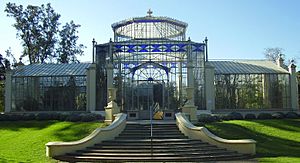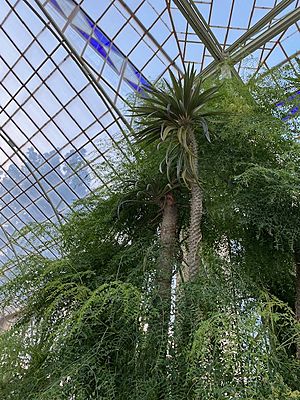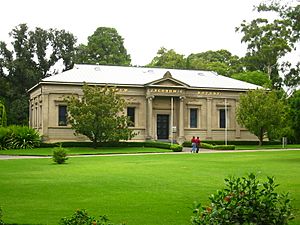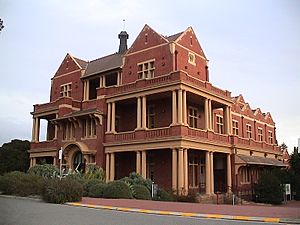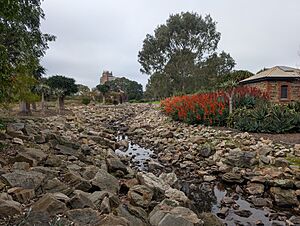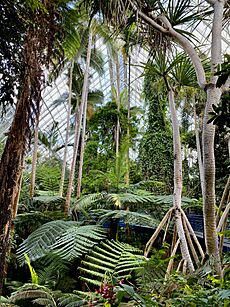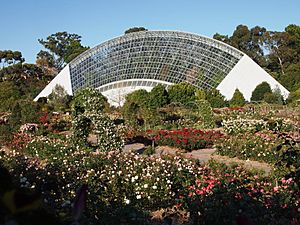Adelaide Botanic Garden facts for kids
Quick facts for kids Adelaide Botanic Garden |
|
|---|---|
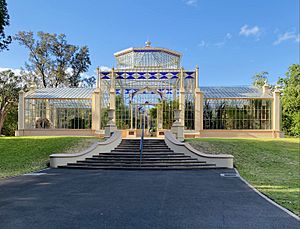
The garden's 1877 tropical palm house
|
|
| Lua error in Module:Location_map at line 420: attempt to index field 'wikibase' (a nil value). | |
| Type | Botanical |
| Location | Adelaide, South Australia |
| Area | 51-hectare (130-acre) |
The Adelaide Botanic Garden is a huge public garden that covers 51 hectares (130 acres). It's located on the edge of the Adelaide city centre in an area called the Adelaide Park Lands. The garden is a beautiful, fenced area on North Terrace. Behind it is the large and open Botanic Park, which is right next to the Adelaide Zoo.
Work to create the garden started in 1855. It officially opened to the public on October 4, 1857.
The Adelaide Botanic Garden is part of a larger group called the Botanic Gardens and State Herbarium of South Australia. This group also includes the Wittunga Botanic Garden, the Mount Lofty Botanic Garden, and the State Herbarium of South Australia. It is managed by a special group appointed by the state government.
Contents
History
The First Idea
When the city of Adelaide was first being planned, its designer, Colonel William Light, wanted it to have a "botanical garden." He chose a spot on a small island in the River Torrens. However, this area flooded too often, so the plan was dropped.
After a few more failed attempts, a gardener named George William Francis arrived in Adelaide in 1849. He urged the governor to create a proper botanic garden. In 1854, the government finally agreed on the location where the garden is today. At the time, the land was a sacred site for the local Kaurna people and was being used to keep police horses.
Building the Garden
George William Francis was put in charge in 1855. He designed the garden's layout and solved the flooding problems. He wanted the entrance to look grand and welcoming.
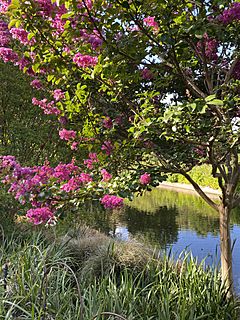
The garden officially opened on October 4, 1857. In 1860, a law was passed to create a Board of Governors to manage the garden, with Francis as the Director. A beautiful pagoda was added in 1863. Francis also started the first herbarium (a library of dried plants) and a botanical library in Adelaide.
A native Australian shrub, Hakea francisiana, was named after him to honor his work.
Later Directors
After Francis retired in 1865, a botanist named Moritz Richard Schomburgk took over. He was passionate about protecting South Australia's forests. Later directors, like M. W. Holtze and John Frederick Bailey, also worked hard to make the gardens a beautiful place for everyone to enjoy.
Historic Buildings
The Adelaide Botanic Garden has several amazing historic buildings that you can still see today.
Palm House
The Palm House, also known as the Tropical House, is a stunning glasshouse built in the Victorian era. It was made in Bremen, Germany, and shipped to Adelaide in 1875. It opened in 1877 and has been carefully restored over the years.
This glasshouse is special because it's the only one of its kind from Germany left in the world. The others were destroyed during World War II. It used to be filled with tropical plants, but now it's home to a collection of unique plants from the dry regions of Madagascar.
Santos Museum of Economic Botany
This museum is all about "economic botany," which means plants that are useful to people. It was started by Director Schomburgk in 1879 and opened in 1881. The building looks like an ancient Greek temple.
Inside, you can see many of the original displays, including amazing models of fruits and fungi made from papier-mâché. The museum also has displays about how Aboriginal people used plants, which were created with help from the South Australian Museum.
Goodman Building and State Herbarium
The main offices for the Botanic Garden are in the historic Goodman Building. This building was built in 1909. Next to it is the State Herbarium, which is like a library for dried plant specimens that scientists use for research.
Old Morgue Building
An old stone building from 1882 still stands in the gardens. It was originally the morgue for the Adelaide Lunatic Asylum, which was located nearby before being torn down in 1938. For many years, the building was just used as a toolshed.
Recently, it was used for an art show called the Adelaide Biennial of Australian Art. An artist named Yhonnie Scarce created an installation inside called In the Dead House.
Displays
The garden has many beautiful displays of plants from Australia and around the world. It even has one of the first Wollemi Pine trees grown by people. This ancient tree was only discovered in the wild in 1994.
Bicentennial Conservatory
This amazing glass building was built to celebrate Australia's Bicentenary in 1988 and opened in 1989. It is 100 meters long, 47 meters wide, and 27 meters high. This makes it the largest single-span conservatory in the Southern Hemisphere.
It was designed to protect endangered rainforest plants from places like northern Australia and Indonesia. For a while, the heating was turned off to save money, but entry is now free for everyone to enjoy the plants inside.
Rose Garden
Started in 1996, the National Rose Trial Garden is the first of its kind in Australia. Here, new types of roses are tested to see how well they grow in Australian weather.
The roses are judged over two years by a team of experts. The best ones receive special awards. In 2004, the singer Sir Cliff Richard visited and planted a rose named after him in the garden.
First Creek Wetlands
To use less water from the River Murray, the garden built a wetlands area in 2013. This system collects rainwater from a local creek. The water is stored underground and then used to water the entire garden.
The wetlands are also an educational display. They teach visitors about the importance of wetland environments. The area is home to about 20,000 plants, many of which are native to Australia, and provides a habitat for local wildlife.
How to Get There
There is a tram stop for the Glenelg tram line right outside the Botanic Garden on North Terrace. This is the last stop on the free BTANIC line, which runs to the Adelaide Entertainment Centre.
| Preceding station | Adelaide Metro | Following station | ||
|---|---|---|---|---|
| University
towards Adelaide Entertainment Centre
|
Glenelg tram line | Terminus | ||
See also
 In Spanish: Jardín Botánico de Adelaida para niños
In Spanish: Jardín Botánico de Adelaida para niños
- Botanic Park, Adelaide
- List of Adelaide parks and gardens


